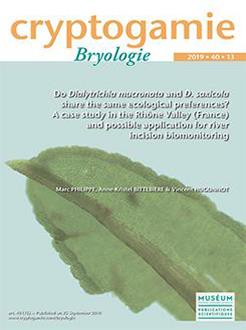Anthropization has led to severe river incision in several parts of Europe. Biomonitoring is of interest to characterize this incision or, conversely, the effectiveness of ecological restoration. Mosses of the upper flood zone are good candidates for such biomonitoring as they are small organisms with limited water-intake ability. Here we studied the Dialytrichia mucronata (Brid.) Broth. – D. saxicola (Lamy) M.J. Cano species pair, both mostly encountered in the upper flood zone; the latter was hypothesized to be more resistant to water stress. We analysed 179 bryosociological relevés in the French Rhône River watershed, distributed along a wide ecological interval. We performed Pearson's Chi-square test to determine whether the latitude, altitude, substrate, and phorophyte had an effect on Dialytrichia (Schimp.) Limpr. species distribution. Assemblages between D. mucronata and D. saxicola and other moss species were tested using a multivariate procedure. Also we compiled a preliminary French departmental scale distribution map for both species. The results showed that the two species differ ecologically and might be more stenoecious than suggested by their wide synecological spectrum. Eighty-three bryophyte species were documented to be associated with the studied species of Dialytrichia. The cumulative projected inertia for the first three axes of the factorial correspondence analysis was only 23.26%, with no clear structuration. It is concluded that neither the relative occurrence of D mucronata and D. saxicola, nor the communities with these species can be used to monitor incision driven changes in vegetation.
A Case Study in the Rhône Valley (France) and Possible Application for River Incision Biomonitoring," Cryptogamie, Bryologie 40(13), 141-152, (25 September 2019). https://doi.org/10.5252/cryptogamie-bryologie2019v40a13





